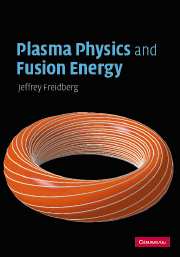Appendix B - Radiation from an accelerating charge
Published online by Cambridge University Press: 14 May 2010
Summary
The purpose of Appendix B is to present a derivation of the formula for the power radiated by an accelerating charge. The derivation requires a complex analysis. An outline of the analysis is as follows. First, a careful definition is given of the “radiation” component of a specified electromagnetic field in the context of Maxwell's equations. Second, a derivation is presented of the formulas that determine the vector and scalar potentials A and φ arising from a general distribution of current and charge densities in the time dependent case. The resulting integral relations are generalizations of the well-known Biot–Savart law and Gauss' theorem from magnetostatics and electrostatics. Third, A and φ, as well as the corresponding electromagnetic fields E and B, are calculated assuming the charge and current densities correspond to a single accelerating charged particle. Finally, these results are combined to evaluate the outward Poynting flux on a surface far from the particle. The integral of the Poynting flux over this surface yields the desired expression for the power radiated by the accelerating charge.
Definition of the radiation field
Assume the existence of a set of localized, time dependent charges and currents. Far from the sources the electric and magnetic fields decay away with distance. Part of these fields corresponds to the “radiation” field and part to the non-radiating “near-field.” What is the precise definition that distinguishes the radiation component of the field from the components of the near-field?
- Type
- Chapter
- Information
- Plasma Physics and Fusion Energy , pp. 650 - 655Publisher: Cambridge University PressPrint publication year: 2007



